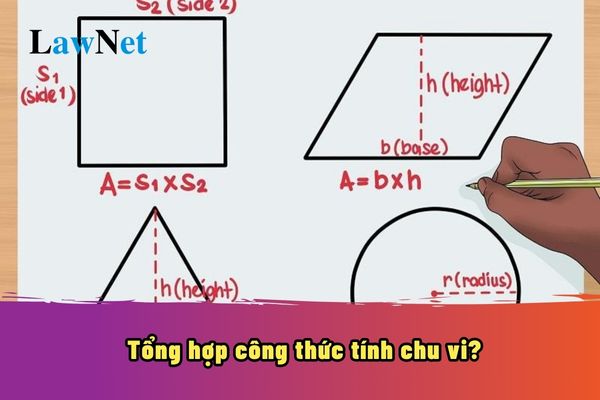What are perimeter formulas? When do students in Vietnam learn about perimeter formulas?
What are perimeter formulas?
The perimeter is the total length of the sides surrounding a shape. Students can refer to the summary table of perimeter formulas below:
Summary of Perimeter Formulas
Triangle
Formula: C = a + b + c
Where:
C: Perimeter of the triangle
a, b, c: Lengths of the three sides of the triangle
Rectangle
Formula: C = 2(a + b)
Where:
C: Perimeter of the rectangle
a: Length
b: Width
Square
Formula: C = 4a
Where:
C: Perimeter of the square
a: Length of one side
Circle
Formula: C = πd or C = 2πr
Where:
C: Perimeter of the circle
d: Diameter of the circle
r: Radius of the circle
π (pi): A constant approximately equal to 3.14
Parallelogram
Formula: C = 2(a + b)
Where:
C: Perimeter of the parallelogram
a, b: Lengths of two adjoining sides
Rhombus
Formula: C = 4a
Where:
C: Perimeter of the rhombus
a: Length of one side
Isosceles trapezoid
Formula: C = a + b + 2c
Where:
C: Perimeter of the isosceles trapezoid
a, b: Lengths of the two bases
c: Length of the side
*Note:
Unit of measurement: When calculating perimeter, ensure that all sides use the same unit of measurement.
Complex shapes: For more complex shapes, one can decompose the shape into simpler shapes, calculate the perimeter of each part, and then sum them.
*Example:
Calculating the perimeter of a rectangle: If the length is 5cm and the width is 3cm, the perimeter of the rectangle is: C = 2(5 + 3) = 16cm.
Calculating the perimeter of a circle: If the diameter of the circle is 10cm, the perimeter of the circle is: C = 3.14 * 10 = 31.4cm.
*Note: The information is for reference only./.

What are perimeter formulas? When do students in Vietnam learn about perimeter formulas? (Image from the Internet)
When do students in Vietnam learn about perimeter formulas?
According to Section 5 of the Mathematics Curriculum of the General Education Program issued with Circular 32/2018/TT-BGDDT, the required achievements for Grade 3 Mathematics include:
Measurement
*Symbols of quantity and measurement units:
- Recognize “area” through specific symbols.
- Recognize the unit of area measurement: cm² (square centimeters).
- Recognize the unit of length measurement: mm (millimeters); understand the relationship between the units m, dm, cm, and mm.
- Recognize the unit of mass measurement: g (grams); understand the relationship between g and kg.
- Recognize the unit of capacity measurement: ml (milliliters); understand the relationship between l and ml.
- Recognize the unit of temperature measurement (°C).
- Recognize the denominations of Vietnamese banknotes (within the range of 100,000 VND); recognize the 200,000 VND and 500,000 VND banknotes (students are not required to read and write the denomination numbers).
- Recognize the months of the year.
Practical measurement
- Use some common tools (such as scales, rulers with millimeter divisions, thermometers,...) for practical weighing, measuring, pouring, and counting.
- Tell the time accurately to 5 minutes and each minute on the clock.
*Calculation and estimation with measured quantities
- Perform conversion and calculations with length measurements (mm, cm, dm, m, km); area (cm²); mass (g, kg); capacity (ml, l); time (minutes, hours, days, weeks, months, years); the Vietnamese currency learned.
- Calculate the perimeter of triangles, quadrilaterals, rectangles, and squares when the side lengths are known.
- Calculate the area of rectangles and squares.
- Make estimates of measurement results in some simple cases (e.g., the weight of a chicken is approximately 2kg,...).
- Solve practical problems related to measurement.
Thus, students first learn perimeter calculation formulas in Grade 3.
What are some activities in the Grade 3 Mathematics program in Vietnam?
According to Section 5 of the Mathematics Curriculum of the General Education Program issued with Circular 32/2018/TT-BGDDT, the required achievements for Grade 3 Mathematics include:
Some probability elements
Recognize and describe the possible (random) outcomes of an event
Recognize and describe the potential (random) outcomes of an event when conducting a simple experiment (e.g., recognizing two possible outcomes for the face of a coin when tossed once; recognizing two possible outcomes for the color of a ball taken from a closed box containing balls of two colors, green or red,...).
The school organizes several activities for students and can supplement other activities depending on specific conditions.
Activity 1: Practical application of mathematical knowledge, such as:
- Practicing activities related to calculation, measurement, and estimation, such as practicing calculating and estimating the perimeter and area of some flat surfaces in reality related to the shapes learned; practicing measuring, weighing, pouring, and estimating length, mass, capacity, temperature,...
- Practicing collecting, classifying, and organizing statistical data (according to specific criteria) on some statistical subjects in school, class.
Activity 2: Organize extracurricular activities (e.g., math learning games or "Fun Learning - Learning Fun" activities; games related to buying and selling, exchanging goods; assembling, folding, stacking shapes; tossing coins, dice,...) related to reviewing and reinforcing math knowledge.

